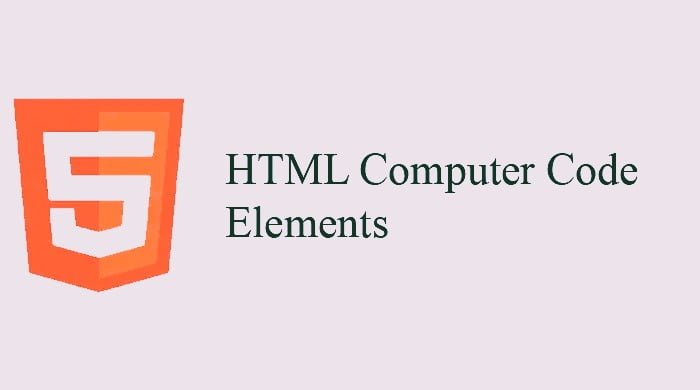HTML Tutorial
- HTML HOME
- HTML Introduction
- HTML Editors
- HTML Basics
- HTML Comments
- HTML Elements
- HTML Attributes
- HTML Headings
- HTML Paragraphs
- HTML Styles
- HTML Text Formatting
- HTML Quotations
- HTML Colors
- HTML Links
- HTML Images
- HTML Favicons: How to Add and Optimize for All Browsers
- HTML Page Title: How to Optimize Titles for SEO Success
- HTML Tables: Create & Optimize for Better Web Design | Codeezy
- HTML Lists: Types, Examples & SEO Tips for Better Structure
- HTML Block and Inline Elements
- HTML Iframes
- HTML File Paths
- HTML Layout
- HTML Computer Code Elements
- HTML Semantics
- HTML5 Semantics
- HTML Entities
- HTML Symbols
- HTML Emojis
- HTML Charsets
HTML Computer Code Elements: Enhance Your Code Presentation

HTML provides a range of elements designed to display computer code on web pages. These elements not only preserve the formatting of the code but also enhance readability, making it easier for users to understand and interact with code snippets. This guide explores the essential HTML elements for presenting computer code effectively.
Key HTML Code Elements
<code>: The<code>tag is used to define a single line of code or code snippets. It does not preserve any whitespace or line breaks but is perfect for inline code.Example Usage:
To include a variable in JavaScript, use <code>let variableName;</code>.
<pre>: The <pre> tag preserves both whitespace and line breaks in code, making it ideal for preformatted text such as code blocks. It displays text exactly as written, which is useful for maintaining the format of code snippets.
Example Usage:
<pre>
function greet(name) {
console.log('Hello, ' + name + '!');
}
</pre>
<samp>: The <samp> tag represents sample output from a computer program. It is often used to show text output from commands or code.
Example Usage:
<p>Command output: <samp>File not found</samp></p>
<kbd>: The <kbd> tag represents user input, typically from the keyboard. It is used to show commands or key sequences that users should input.
Example Usage:
Press <kbd>Ctrl</kbd> + <kbd>C</kbd> to copy text.
<var>: The <var> tag is used to represent a variable in a mathematical expression or programming code. It is ideal for showing variable names in formulas or code snippets.
Example Usage:
The formula for area is <code>Area = <var>width</var> * <var>height</var></code>.
Example: HTML Code Elements in Action
Here’s an example demonstrating how these HTML code elements can be used together to display code and output clearly:
<!DOCTYPE html>
<html>
<head>
<title>HTML Code Elements Example</title>
<style>
pre {
background-color: #f4f4f4;
border: 1px solid #ddd;
padding: 10px;
overflow-x: auto;
}
code {
color: #d63384;
}
samp, kbd, var {
font-family: monospace;
background-color: #f8f9fa;
padding: 2px 4px;
border: 1px solid #ddd;
border-radius: 4px;
}
</style>
</head>
<body>
<h2>HTML Code Elements Example</h2>
<p>Inline code example: <code>let x = 10;</code></p>
<p>Preformatted code example:</p>
<pre>
function add(a, b) {
return a + b;
}
</pre>
<p>Sample output from a command: <samp>Operation completed successfully</samp></p>
<p>Keyboard input example: Press <kbd>Enter</kbd> to submit.</p>
<p>Mathematical variable example: The area of the rectangle is <code><var>width</var> * <var>height</var></code>.</p>
</body>
</html>
Best Practices for Using HTML Code Elements
- Use
<code>for Inline Code: When you need to include code within a paragraph or sentence, use the<code>tag to style and differentiate it from regular text. - Apply
<pre>for Preformatted Code Blocks: For larger code snippets or blocks, use the<pre>tag to preserve the formatting and spacing. - Highlight Sample Output with
<samp>: Use the<samp>tag to display output from commands or program results clearly. - Show User Input with
<kbd>: Indicate keyboard shortcuts or user commands with the<kbd>tag to make instructions more intuitive. - Represent Variables with
<var>: Use<var>to denote variables in equations or code snippets for clear representation.
Conclusion
Mastering HTML code elements ensures that code snippets and related text are presented clearly and effectively on your web pages. By utilizing <code>, <pre>, <samp>, <kbd>, and <var>, you can enhance the readability and accessibility of code, making it easier for users to understand and interact with.
Thank You for Visiting Codeezy.org!
We’re thrilled to have you as part of our coding community. Your engagement and support inspire us to continue providing high-quality resources and tools to enhance your web development journey. Whether you’re a beginner or an experienced coder, we hope you found valuable insights and tools here at Codeezy.
Stay connected for more tips, tutorials, and updates to help you code with ease. Thank you for choosing Codeezy.org—your growth as a developer is our motivation!
Happy coding!
